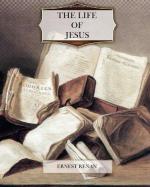[Footnote 1: John vi. 32, and following.]
[Footnote 2: We find an analogous form of expression provoking a similar misunderstanding, in John iv. 10, and following.]
[Footnote 3: A11 these discourses bear too strongly the imprint of the style peculiar to John, for them to be regarded as exact. The anecdote related in chapter vi. of the fourth Gospel cannot, however, be entirely stripped of historical reality.]
It is probable that from that time, in the common repasts of the sect, there was established some custom which was derived from the discourse so badly received by the men of Capernaum. But the apostolic traditions on this subject are very diverse and probably intentionally incomplete. The synoptical gospels suppose that a unique sacramental act served as basis to the mysterious rite, and declare this to have been “the last supper.” John, who has preserved the incident at the synagogue of Capernaum, does not speak of such an act, although he describes the last supper at great length. Elsewhere we see Jesus recognized in the breaking of bread,[1] as if this act had been to those who associated with him the most characteristic of his person. When he was dead, the form under which he appeared to the pious memory of his disciples, was that of president of a mysterious banquet, taking the bread, blessing it, breaking and presenting it to those present.[2] It is probable that this was one of his habits, and that at such times he was particularly loving and tender. One material circumstance, the presence of fish upon the table (a striking indication, which proves that the rite had its birth on the shore of Lake Tiberias[3]), was itself almost sacramental, and became a necessary part of the conceptions of the sacred feast.[4]
[Footnote 1: Luke xxiv. 30, 35.]




